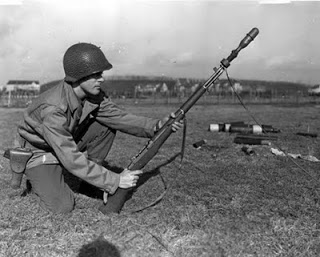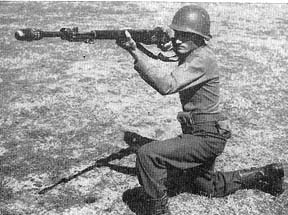"5 Differences Between Army and Marine Infantry."
The Marine Corps rifle platoon contains three rifle squads. Each squad is led by a sergeant who has three fire teams working for him, each led by a corporal. The fire team leader typically carries the M203 grenade launcher slung under his M16. Operating under him are the automatic rifleman, assistant automatic rifleman, and rifleman. The Army platoons contain smaller squads. An Army rifle squad leader is typically a sergeant or staff sergeant who leads two four-man fire teams. Each Army fire team consists of a team leader, an automatic rifleman, a grenadier, and a rifleman. Note that the Army squad is using a dedicated grenadier in place of an assistant automatic rifleman. Typically, one rifleman in each squad will be a squad designated marksman, a specially trained shooter who engages targets at long range. Also, the Army has an additional squad in each platoon, the infantry weapons squad. This squad has teams dedicated to the M240B machine gun and the Javelin missile system.
MBV Note: For militia, I have always preferred the larger 13 man USMC squad of three fire teams of four plus a squad leader, with a designated marksman in each fire team to take up for the slack of no permitted base-of-fire full auto weapons. Of course, I always assumed that after the balloon went up, there would also be one rifle grenadier per fire team as well.


2 comments:
Only way to settle this is to take the best of the Marines and pit them against the worst of Mean Green and allow them all to "Get Some".
Big advantage of the Marine three fire team squad is more options and unpredictability - the ability to do feints, to have a fire team in reserve, to do double envelopments, etc. all adding up to the increased possibility of surprise. The enemy may not even realize there is a third element present, which can be used as an overwatch element, or rear "shadow" element, and only engages from a position of surprise on the enemy, which is focused on what it thinks are just two standard Army fire teams, without realizing there is a third element maneuvering on a flank.
For example, the two lead fire teams are moving forward in "bounding overwatch" as the third fire team hangs back a bit and "shadows" the rearmost of the two forward fire teams (such as by staying to the rear, and/or on whatever high ground is on a rear flank). The two lead fire teams make contact with the enemy and decide to break contact, by bounding backwards. As they do so, the rearmost "shadow" fire team moves to a flank and on high ground, and sets up a hasty ambush. the two lead fireteams bound back, past the hidden hasty ambush set by the third fire team. The enemy, thinking it has our guys on the run, attacks agressively, focused on the two bounding teams it can see, and who are actively firing, as they bound back, breaking contact. The enemy doesn't even know the third team exists, and has no idea it is being sucked into an ambush.
Once enough of the enemy are in the kill zone, the third fire team opens up, and at that time, both of the other two fire teams stop bounding, go online with each other, and become the bottom of an "L" shaped ambush. One of those teams would already have been firing as the other bound back, so all the bounding team would have to do is bound back online, rather than past the team that was providing a temporary base of fire. So, all three fire teams are now lighting the enemy up in an L shaped ambush, and the enemy may not even realize it is taking fire from the flank, and even if it does, it is still screwed, since the flank element is firing at right angles to the enemy's cover (if any).
It is likely that while chasing the "retreating" fire teams, the enemy got all strung out and uncoordinated, and is not in an effective formation to fight well to the flank (maybe they all went online, or are now in an uncoordinated gaggle, as they run forward, firing).
Either way, they are SURPRISED from the flank, and have been sucked in and hit hard during their moment of perceived victory.
That is just one example of how three fire teams can be used. And imagine if each of them had a designated marksman, as Mike said, who can not only provide precision fire at long range, but also at short range, such as head shots and taking out key personnel on the ambushed enemy element as it unwittingly moves through the kill zone it doesn't even know is there. It is possible the enemy will never even realize it is taking fire from the flank at all, and never figure out who shot their leaders and commo men in the head.
And then add in a two man sniper team who can move around outside the "bubble" of contact and provide precision fire as needed, from a different direction, to kill those escaping the ambush, to nail those attempting to flank the hasty ambush, stop reinforcements, etc. Fun, fun, fun. - Stewart Rhodes
Post a Comment